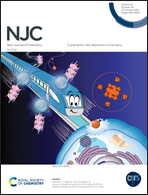The effect of resonance-assisted hydrogen bond on the second-order nonlinear optical properties of pyridine hydrazone photoswitches: a quantum chemistry investigation†
Abstract
The effect of hydrogen bonds on the NLO properties was not considered as essential, in particular in pyridine hydrazone systems. Yet, we show in the present study that a control of these photoswitches depends on the strength of hydrogen bonds. In this study, we investigate a selection of 18 E/Z pyridine hydrazone photoswitch molecules to explore the impact of resonance-assisted hydrogen bond (RAHB) on the NLO properties in the E/Z isomers. Using quantum calculations at the ωB97XD/6-311+g(d) level of theory, we determine various electronic parameters, reactivity descriptors, bond length alternation (BLA) values, nuclear independent chemical shift (NICS) aromaticity indices, QTAIM topology, energy of hydrogen bond (EHB), RAHB, and linear and nonlinear optical properties for these molecules. The agreement between the quantum calculations and experimental spectra is illustrated through TD-DFT calculations, showing small deviations. Contrary to conventional expectations, our findings demonstrated that the delocalization strength of the electrons and NLO properties of the Z isomers are significantly enhanced by the presence of a resonance-assisted hydrogen bond. The Z-isomer exhibited a lower excited state energy, weaker energy gap, smaller BLA value, larger dipole moment variations for the first excited state, higher ΦE→Z, and electron delocalization at the quasi-cycle closed (RAHB) compared to the E-isomer. Furthermore, we find that the hyperpolarizability value of the title photoswitches increases as the wavelength of the incident light decreases, i.e., β(695) > β(1064) > β(1340) > β(∞), and the dispersion has less effect at λ = 1064 and 1340 nm. Additionally, we observe a strong relation between the photoisomerization quantum yield (ΦE⇄Z) and static hyperpolarizability (β) of the first and second isomer, where ΦE⇄Z is proportional to β of the second isomer and inversely proportional to b of the first isomer. This inverse trend between static hyperpolarizability and photoisomerization quantum yields is attributed to the electron-withdrawing character of substituents on the Ar ring. Our research provides valuable insights into optimizing the 2nd-order NLO properties of pyridine hydrazone photoswitch molecules. By understanding the influence of hydrogen bonding on the delocalization strength of the electrons (RAHB) and the shape-dependent NLO performance, we gain the ability to design and synthesize novel photoswitch molecules with enhanced NLO characteristics.



 Please wait while we load your content...
Please wait while we load your content...